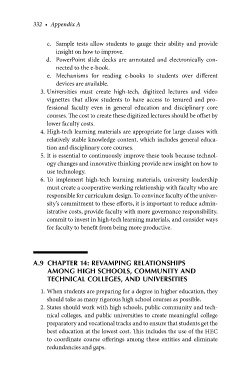Page 362 - Crisis in Higher Education
P. 362
332 • Appendix A
c. Sample tests allow students to gauge their ability and provide
insight on how to improve.
d. PowerPoint slide decks are annotated and electronically con-
nected to the e-book.
e. Mechanisms for reading e-books to students over different
devices are available.
3. Universities must create high-tech, digitized lectures and video
vignettes that allow students to have access to tenured and pro-
fessional faculty even in general education and disciplinary core
courses. The cost to create these digitized lectures should be offset by
lower faculty costs.
4. High-tech learning materials are appropriate for large classes with
relatively stable knowledge content, which includes general educa-
tion and disciplinary core courses.
5. It is essential to continuously improve these tools because technol-
ogy changes and innovative thinking provide new insight on how to
use technology.
6. To implement high-tech learning materials, university leadership
must create a cooperative working relationship with faculty who are
responsible for curriculum design. To convince faculty of the univer-
sity’s commitment to these efforts, it is important to reduce admin-
istrative costs, provide faculty with more governance responsibility,
commit to invest in high-tech learning materials, and consider ways
for faculty to benefit from being more productive.
A.9 CHAPTER 14: REVAMPING RELATIONSHIPS
AMONG HIGH SCHOOLS, COMMUNITY AND
TECHNICAL COLLEGES, AND UNIVERSITIES
1. When students are preparing for a degree in higher education, they
should take as many rigorous high school courses as possible.
2. States should work with high schools, public community and tech-
nical colleges, and public universities to create meaningful college
preparatory and vocational tracks and to ensure that students get the
best education at the lowest cost. This includes the use of the HEC
to coordinate course offerings among these entities and eliminate
redundancies and gaps.

